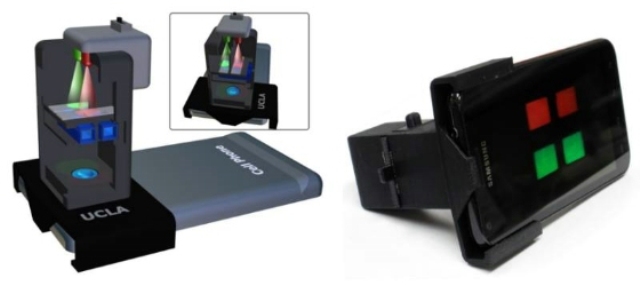A team of researchers from the UCLA Henry Samueli School of Engineering and Applied Science has developed a smartphone attachment and application to test water for the presence of mercury, a toxic heavy metal. The new platform could significantly reduce the time and cost of the testing, and it could be particularly useful in regions with limited technological resources.
 A UCLA-developed smartphone attachment tests water for mercury contamination.
A UCLA-developed smartphone attachment tests water for mercury contamination.
Traditionally, water has been tested for mercury contamination in laboratories using large, expensive instruments, and the procedure requires complex preparation by professionally trained personnel. The new technology uses an inexpensive and lightweight attachment that was produced at UCLA using a 3-D printer, and the test can be performed easily by anyone after only minimal training.
"Our new platform for mercury testing is essentially a lab on a phone," said Aydogan Ozcan, the Chancellor's Professor of Electrical Engineering and Bioengineering at UCLA, associate director of the UCLA California NanoSystems Institute and the principal investigator on the research. "It's portable, lightweight and inexpensive to manufacture. And, because of the global proliferation of mobile devices, it could make testing for mercury widely available. Having this kind of test available in resource-limited areas and in the field was an important motivation for our work."
The research has been published online in the peer-reviewed journal ACS Nano.
To perform the test, a user collects a water sample in a disposable test tube and then holds it up to a smartphone equipped with the optical attachment. Using the attachment's light-emitting diodes, which are set to two specific frequencies, the device detects subtle changes in how light is transmitted to the phone's built-in camera due to mercury-induced nanoparticle clustering in the water.
The test, which uses nanoscale gold particles and short fragments of synthetic DNA that are extremely sensitive to the presence of mercury ions, can detect mercury concentrations of 3 to 4 parts per billion (ppb), which is about the maximum safe concentration level for drinking water according to standards set by the U.S. Environmental Protection Agency (2 ppb), and the World Health Organization (6 ppb).
The entire process can take as little as 20 minutes per test, including 10 minutes of incubation time.
The platform also includes an Android app that processes the images and quantifies the test results, then organizes the results from tested sites into an online map. This could help track mercury pollution in the environment.
The researchers estimate that the cost per test could be as low as five cents. The attachments, which weigh less than 40 grams, cost about $37 each to produce using a 3-D printer, and could be manufactured at a lower cost if they are made in large quantities.
Other members of the interdisciplinary team are Qingshan Wei, a UCLA postdoctoral scholar and lead author on the research; UCLA undergraduates Richie Nagi, Kayvon Sadeghi, Eddie Yan and So Jung Ki, and UCLA researchers Steve Feng, Romain Caire and Derek Tseng.
Financial support for the Ozcan Research Group was provided by the Presidential Early Career Award for Scientists and Engineers, the Army Research Office Life Sciences Division, an ARO Young Investigator Award, the U.S. Army Tank Automotive Research, Development and Engineering Center, the National Science Foundation CAREER Award, the NSF CBET Division Biophotonics Program, an NSF Emerging Frontiers in Research and Innovation Award, the Office of Naval Research and a National Institutes of Health Director's New Innovator Award.
Ozcan, who joined the UCLA Engineering faculty in 2007, also has a faculty appointment at the UCLA David Geffen School of Medicine. He holds more than 20 patents and has several pending patent applications related to optics and nanoscopy. He has been named one of Popular Science magazine's "Brilliant 10" young innovators, and he received the NIH Director's New Innovator Award, the NSF CAREER Award and young investigator career awards from both the ONR and ARO. In 2011, Ozcan won a Presidential Early Career Award for Scientists and Engineers, as well as the Early Career Achievement Award from SPIE, the international society for optics and photonics. He is a fellow of SPIE and the Optical Society (OSA) and a founder of the mobile microanalysis startup company Holomic LLC.